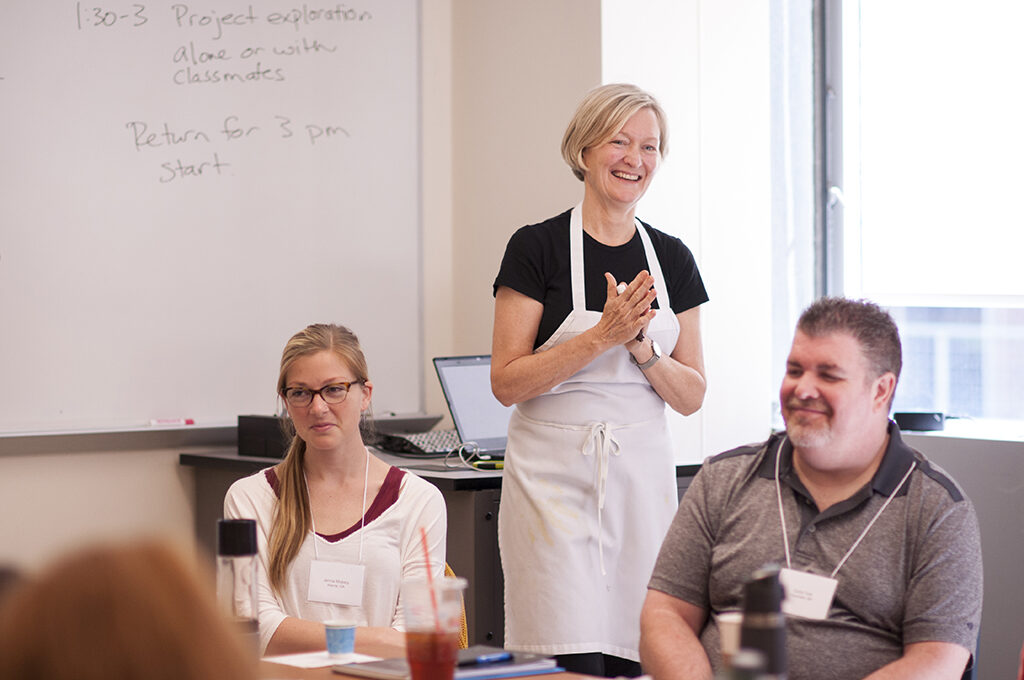
The UVM Foods Lab serves as the hub for experiential learning for culinary, nutrition, and food science classes at the University of Vermont. All of these courses are based around the goal of building Food Agency, or a person’s ability to procure and prepare food with confidence, whatever their broader social, physical, and economic context. Students learn food science principles, organizational and culinary skills and techniques. These are not exercises in abstraction; rather these are realized through a process of meal preparation and as this happens, students see the impact the taste, texture, smell, and appearance of the food they create; along the way they build confidence and become more comfortable making decisions and solving problems in the kitchen.
Our courses build upon these skills and knowledge through a combination of traditional classroom assignments and intensive hands on learning opportunities. Students in hybrid and in-person classes come into the kitchen lab for demonstrations and active cooking labs, while students in hybrid and online classes cook in their own kitchens following live or recorded demos. Most classes offer students 75 to 90 minutes of cooking time each week, followed by reflection on the cooking process, the sensory outcome, and how the two impacted each other. This opportunity to apply what they’re learning in the kitchen each week, make mistakes and recover from them, and taste the products of their work empowers students to make connections between the concepts they learn, how they prepare their food, and how their food tastes.
The Three Pillars of Our Courses
Base of Culinary Skills: A fundamental tenet of attaining food agency in the Foods Lab involves improving students’ basic organizational and culinary skills. Our classes include lessons on basic food safety, knife skills, tool selection and use, organization, problem solving, and recipe analysis. All of our introductory active cooking classes start with an overview of knife safety, care, and several basic knife cuts (chop, dice, mince, julienne, etc.) to make sure students are handling the knives safely and considering how their knife cuts impact the way the food cooks and tastes. Students also begin the course by learning about mise en place (“everything in its place”), going through each recipe to identify and draw out what tools and ingredients they will need and how they will organize their space and the steps to use both efficiently. As the recipes become more complicated, we introduce students first to forwards sequencing (rearranging and writing out the steps of the recipe(s), pulling out hidden steps and grouping similar tasks to save time) and then backwards sequencing (writing out the steps of the recipe(s) as with forward sequencing, but starting with the last step and working backwards with a specific finishing time in mind). These three organizational skills in particular help students feel more in control throughout the process of cooking and help build their confidence addressing any issues that might arise in the kitchen.
Basic Concepts of Food (Food Science): Understanding a few basic food science concepts is another great way to build confidence and skill in the kitchen. The core basic concepts of food that we cover in our introductory courses are the following: heat transfer, gelatinization and retrogradation of starch, emulsification, smokepoints, protein denaturation and coagulation, the Maillard reaction, caramelization, and gluten formation. As students learn the basic science behind why eggs firm up as they cook or why you add the flour last to a cake batter, they begin to see how these processes impact their food and how they can use this knowledge to reach certain desired flavors, textures, etc.
Sensory Analysis: Learning to describe and analyze the sensory aspects of food is another key component in building Food Agency. We lead students through sensory analyses (link to worksheet) of all of the meals they create in class, closely examining the appearance, smell, taste, texture, temperature, and memory associations of the food. It is challenging yet important to be able communicate to others about an internal sensory experience. As they expand their vocabularies and pay closer attention to how different cooking techniques, ingredients, and decisions impact the final sensory experience of their dishes, they become more confident making informed decisions during the cooking process. These decisions tie back to the lessons on food science and culinary skills as they make connections between the temperature they use when searing meat or when they dress their salad and the final taste, texture, etc. of their meal.
Tools and Resources
- Tools: some of the tools we’ve developed for our courses
- Resources: Cookbooks, websites, videos, and other resources we use regularly in our courses
Interested in learning more?
To learn more about this work you can contact Emily Barbour (ebarbour@uvm.edu).